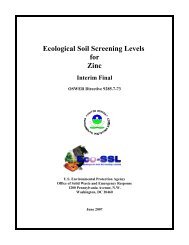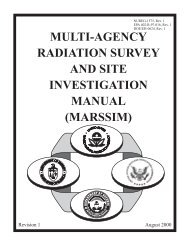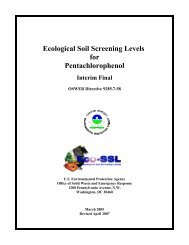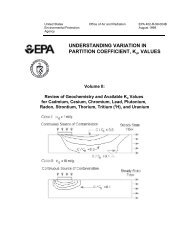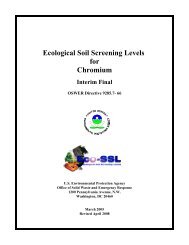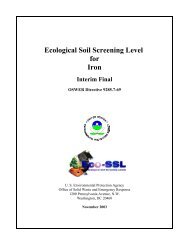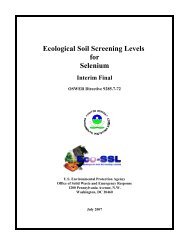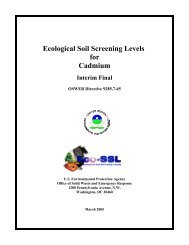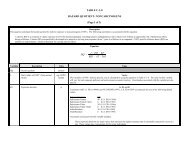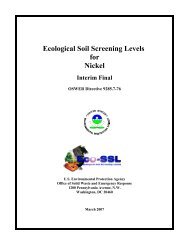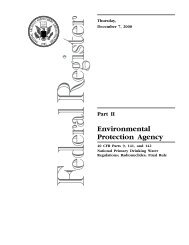Guidance for Conducting Risk Assessments and Related Risk ...
Guidance for Conducting Risk Assessments and Related Risk ...
Guidance for Conducting Risk Assessments and Related Risk ...
You also want an ePaper? Increase the reach of your titles
YUMPU automatically turns print PDFs into web optimized ePapers that Google loves.
• the prioritization of projects/activities;<br />
• the establishment of clean-up criteria that are protective of human health <strong>and</strong> the environment;<br />
• the effectiveness of selected remedies;<br />
• the determination of source terms <strong>and</strong> estimating probability <strong>and</strong> magnitude of release due to<br />
catastrophic events or deterioration of existing structures or containment systems;<br />
• the effectiveness of treatment technologies; <strong>and</strong><br />
• the risk from residual materials, infrastructure, <strong>and</strong> chemicals in building/structures slated <strong>for</strong> re-use.<br />
The risk assessment guidelines outlined in the original document, <strong>Risk</strong> Assessment Strategy at DOE-<br />
ORO (ES/ER/TM-180, LMES 1996c), have been updated <strong>and</strong> incorporated into this document. The focus<br />
of TM-180 was to ensure that all risk assessment <strong>and</strong> related risk activities in support of environmental<br />
restoration ef<strong>for</strong>ts, namely the CERCLA RI/FS process, would be “per<strong>for</strong>med in a consistent <strong>and</strong><br />
technically defensible manner”.<br />
The goal of this document is similar to ES/ER/TM-180, but the scope has been exp<strong>and</strong>ed to address<br />
other uses of risk assessment <strong>and</strong> related risk activities that support decision-making [e.g., waste<br />
management, decontamination <strong>and</strong> decommissioning (D&D), technology demonstration, <strong>and</strong><br />
reindustrialization ef<strong>for</strong>ts].<br />
1.1 PURPOSE AND SCOPE<br />
The purpose of this document is to establish guidelines to ensure that all risk assessments <strong>and</strong><br />
related risk activities <strong>for</strong> the DOE-ORO EM Program are consistent with both program <strong>and</strong> regulatory<br />
guidance <strong>and</strong> are technically defensible. This is especially important under the M & I contracting process<br />
because subcontractors will per<strong>for</strong>m most risk assessment tasks. The use of this document will streamline<br />
the completion of human health risk assessments by providing program <strong>and</strong> project managers with a<br />
framework that integrates risk assessment activities into the life cycle of projects.<br />
The methods outlined in this document are consistent with the U.S. Environmental Protection<br />
Agency’s (EPA) human health evaluation process described in parts A through D of <strong>Risk</strong> Assessment<br />
<strong>Guidance</strong> <strong>for</strong> Superfund Volume I: Human Health Evaluation Manual (RAGS) (EPA 1989, 1991a,<br />
1991b, 1998). Under CERCLA, RAGS serves as the primary regulatory guidance document <strong>for</strong> all risk<br />
assessments <strong>and</strong> its application to risk management. In addition to RAGS, comments provided by state<br />
<strong>and</strong> federal regulators on previously submitted risk assessment reports <strong>and</strong> the most up-to-date scientific<br />
findings related to the evaluation of human health risk have been incorporated into this document.<br />
The Paducah risk assessment guidance document, Methods <strong>for</strong> <strong>Conducting</strong> Human Health <strong>Risk</strong><br />
<strong>Assessments</strong> <strong>and</strong> <strong>Risk</strong> Evaluations at the Paducah Gaseous Diffusion Plant (DOE/OR/07-1506&D1,<br />
DOE 1996) was prepared to incorporate requirements of the State of Kentucky <strong>and</strong> EPA Region IV.<br />
Although the Paducah risk assessment guidance document references this document, the Paducah<br />
guidance is to be considered “site-specific”. All risk assessments <strong>and</strong> risk evaluations at the Paducah<br />
Gaseous Diffusion Plant must comply with the requirements outlined in Methods <strong>for</strong> <strong>Conducting</strong> Human<br />
Health <strong>Risk</strong> <strong>Assessments</strong> <strong>and</strong> <strong>Risk</strong> Evaluations at the Paducah Gaseous Diffusion Plant (DOE/OR/07-<br />
1506&D1, DOE 1996) or its most recent revision.<br />
2



